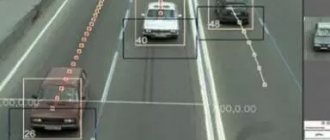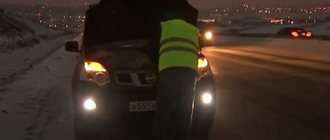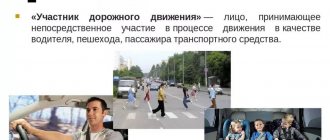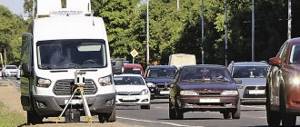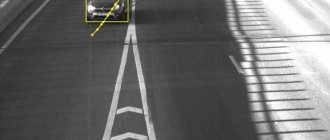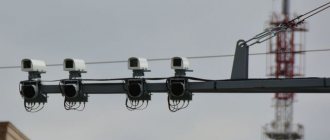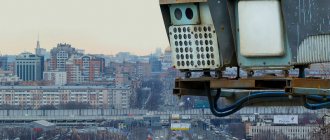Legislative basis for recording road accidents
The video recording system for traffic violations operates in accordance with two articles prescribed in the Code of Administrative Offenses of the Russian Federation:
- Article 26.8. The legislative act specifies the requirements for video recording of violations that can be used on the roads. Special equipment means photo and video cameras, devices for recording vehicle speed and other equipment that has passed metrological testing. The driver’s guilt can be proven if traffic violations were recorded using certified devices.
- Article 2.6.1. The legislative act confirms the legality of the use of video and photography cameras by traffic police officers. Technical means record not only the speed of the vehicle at the time of violation of traffic rules, but also the markings on the road. When cameras record crossings of a solid lane or perform maneuvers on dangerous sections of the road, the driver will bear administrative responsibility.
In accordance with the current laws of the Russian Federation, a special sign in the form of a camera is installed in the area of video recording.
In case of violation of traffic rules on the road, which were recorded by a camera, they are guided by the following legislative acts:
- GOSTs R 57144-2016 and R 57145-2016 – on video and photo recording devices;
- current editions of traffic regulations;
- Code of Administrative Offenses section 4, articles 2, 6, 12, 26, 28, 30 and 32;
- regulations of traffic police officers in accordance with Order of the Ministry of Internal Affairs No. 664 of October 20, 2017.
According to statistics, the installation of security cameras on dangerous sections of the road has already yielded results. Over the past year, the number of major and minor car accidents has decreased by 15-18%.
Today, means of automatically recording traffic violations operate in almost all regions of Russia, with the exception of Crimea, Sevastopol and the Chukotka Autonomous Okrug. Complexes for automatically recording violations of the Traffic Rules cover 6.2 thousand stationary and 4.1 thousand variable control zones.
In the regions there are Centers for automated recording of administrative offenses, which accumulate data on traffic violations committed by drivers and recorded by systems operating in automatic mode. Here decisions on cases of administrative offenses are drawn up, which are then sent to vehicle owners along with fines.
Systems for automatically recording traffic violations are actively developing today. Thus, at the end of 2015, more than 50 million decisions were made against vehicle owners on the basis of materials recorded by the complexes in cases of administrative offenses, which amounted to 67% of the total number of decisions made against owners and drivers of vehicles. The same figure for 2014 was 40.9 million or 63% of all decisions made.
Currently, about 3.7 thousand stationary complexes (76%) are focused on detecting exceeding the set speed. Such violations under Art. 12.9 of the Code of Administrative Offenses of the Russian Federation in 2015, 44.9 million were detected, which is 89% of the total number of offenses recorded automatically.
At the same time, in the past year the range of types of detected traffic offenses has been expanded. Today, on the territory of the Russian Federation, there are 272 complexes designed to automatically record violations of the rules of passage of controlled intersections (in 2014 there were 187), 258 - to record the facts of entering the lane intended for oncoming traffic, and driving under the sign “No entry” "(in 2014 there were 193 of them), 43 - to record violations in the areas of railway crossings (in 2014 - 6), 34 - to record facts of failure to provide priority in traffic to pedestrians in the area of pedestrian crossings (in 2014 these complexes were not yet operational ).
Also, in automatic mode, 414 complexes record facts of vehicle movement in public transport lanes (in 2014 - 352), 396 - violations of stopping and parking rules (in 2014 - 368), 163 - violations of the requirements of the sign “Truck traffic is prohibited” (in 2014 – 53 complexes). At the same time, the share of the listed offenses recorded automatically in 2015 was 10.5% of the total (in 2014 – 8.7%).
In addition, technical solutions for recording other types of traffic violations are being developed. The analysis of the effectiveness of the use of complexes shows that in places where they are constantly functioning, there is a decrease in both the total number of road accidents and the severity of their consequences.
Now, in accordance with the traffic rules, signs 8.23 “Photo and video recording” are placed in places where stationary systems are installed and road markings duplicating them are applied. As the experience of other countries has shown, informing drivers about the automatic recording of offenses brings a tangible preventive effect and helps reduce the level of accidents on these sections of roads. At the same time, it should be noted that the installation of such a sign, which is a sign of additional information, has the purpose of informing road users about the possible recording of an administrative offense only by stationary technical means.
The absence of such an information sign does not mean that drivers can ignore the duties prescribed by the Rules, and does not entail the unconditional recognition as unacceptable of evidence obtained using technical means. This position is confirmed by the judicial practice of a number of regions of the Russian Federation.
The State Traffic Inspectorate notes that, despite the expansion of the scope of application of the complexes, their functioning is aimed, first of all, at preventing violations of the Traffic Rules - first of all, the installation of automatic complexes should affect the discipline of drivers, prevent a possible offense, and, consequently, accidents which it can provoke.
GUOBDD MIA of Russia
.
What violations are recorded by video cameras?
The video recording system for traffic violations is equipped with devices that determine the speed of movement and the intersection of vehicles with road markings. The cameras recognize many administrative violations of drivers:
- speeding;
- driving into the oncoming lane or onto the side of the road;
- overtaking vehicles on turns;
- failure to comply with traffic rules at intersections;
- stopping a vehicle under prohibitory signs;
- vehicle movement at a red traffic light;
- stopping at a traffic light behind the stop line;
- hitting a pedestrian crossing area when stopping;
- performing prohibited maneuvers;
- going to the “waffle iron” during a traffic jam;
- turning the vehicle from the outermost lane;
- unfastened seat belt;
- entering the lane for special categories of transport;
- ignoring signs prohibiting movement.
Due to the promising nature of the project, photo and video surveillance cameras are constantly being improved. Therefore, the list of registered violations will soon expand.
What violations are recorded by video cameras?
As we said earlier, there are many different systems for photo and video recording of traffic violations. I would like to consider the main violations that are recorded on our roads.
Over speed. This is probably why the cameras were installed, since there are a lot of reckless drivers on the roads, and no one wants to slow down. After paying several fines, you are unlikely to want to violate any more. And, by the way, if you have “chain letters” at home with fines totaling 10,000 rubles or more, then I advise you to pay for them, since they will not let you out of the country.
Driving into the oncoming lane. This is a gross violation, which, if you are stopped by an inspector, entails a large fine or deprivation of your license. It is better not to drive into oncoming traffic at all in unauthorized places.
Entering a designated lane. These lanes are intended for public transport. Many drivers think why stand in a traffic jam if there is a free lane. This, of course, is true, but if this flow also “stops,” then the buses will not be able to freely deliver their passengers to their destination.
Unfastened seat belt. Such cameras are also quite widespread throughout Russia. takes a photo if the driver is not wearing a seat belt.
Also, in the near future, they promise to install systems that will record the intersection of the stop line at a prohibitory traffic light sign, as well as the failure to give priority to a pedestrian while crossing the road at a zebra crossing. It is expected that instead of the usual photographic recording, a short video recording will be made, which will clearly prove the guilt of the motorist. In this case, separate cameras will not be installed; simply reprogramming will be done on old complexes.
Do not forget that a new system for determining the average speed of a car is already in effect. The principle of operation is simple: cameras are hung at a distance of several kilometers that measure the speed at the entrance to a given area and at the exit. If the average speed is exceeded, the driver of the vehicle receives a letter with a fine. This system is already in effect in 17 regions of the country.
Important!
If you received a fine by mail for driving unfastened or without the low beams on, with a photo from the camera attached, then you should first find out whether this complex is certified for such violations or not. If not, then this fine will be declared invalid if it is appealed in court.
Fines from cameras
Typically, video surveillance systems are installed on dangerous and busy sections of the road. Therefore, the likelihood of receiving “chain letters” is relatively low. In accordance with the Code of Administrative Offenses of the Russian Federation, Part 3 of Art. 1.5, the driver is not required to prove his innocence in the event of an administrative violation. But in the same regulatory legal act there is a clause that states that the presumption of innocence does not apply if the violation is recorded by a camera or other licensed equipment.
Dimensions
There is a difference between fines that are issued by traffic police officers and those that are recorded by a video surveillance system. The following rules apply to security cameras:
- Regardless of the seriousness of the violations, the driver is not deprived of his right to drive a vehicle;
- if the article provides for the deprivation of a driver’s license, the offender is issued the maximum fine;
- For relatively minor violations, a minimal fine is issued.
Amounts of fines when an offense is recorded by a video surveillance system
| Violations | Amount of fine, in rubles | |
| over speed | 20-40 km/h | 500 |
| 40-60 km/h | 1000 | |
| 60-80 km/h | 2500 | |
| from 80 km/h | 5000 | |
| driving into the oncoming lane | 5000 | |
| driver's seat belt unfastened | 1000 | |
| Unfastened seat belt of the front passenger | 500 | |
| talking on the phone while driving | 1000 | |
Many drivers do not like the innovations associated with the installation of security cameras. But in reality, none of the violations recorded by the camera threaten the car owner with deprivation of his driver’s license.
How is a decision made?
When a violation is recorded by a camera, traffic police officers determine the vehicle number in the traffic police database. Then an administrative violation report is drawn up, after which the car owner receives a notification from the traffic police. It contains information about:
- car model and make;
- vehicle registration number;
- photo of the offense;
- the amount of the fine;
- the essence of the violation, indicating the article of the Code of Administrative Offenses of the Russian Federation.
In accordance with current legislation, the fine must be paid within 60 days. If the letter is ignored, the owner of the vehicle will be prosecuted or the fine will be increased. It is paid in different ways:
- On the State Services website. A personal account is created on the website indicating all the necessary information - passport details, phone number, etc. The fine is paid electronically from an online wallet or bank card.
- In offline branches of Russian banks. You just need to deposit the required amount through an ATM or go to the cashier. If you are registered in online banking, you can pay the fine without leaving your home.
Fines issued by the traffic police must be paid within 60 days. Delay may result in administrative penalties and additional charges.
How to challenge a fine
If the driver is confident of his innocence, he can appeal the decision of the traffic police within 10 days. To avoid such situations, experts advise purchasing personal video recorders. In this case, you can use your footage as evidence of innocence.
How to appeal decisions of traffic police officers:
- if you disagree with the claims and fines presented, you must send a complaint to the relevant authorities, attaching evidence refuting the fact of the offense;
- the application is submitted to the official who made the decision;
- The traffic police officer sends the application to the court.
Security cameras sometimes malfunction. At the moment a violation is recorded, the driver does not always actually break the law. Sometimes video surveillance systems record speeds that cannot be real - 250-320 km/h.
How do video cameras work to record violations?
Today there are a great variety of camera types. They are classified not only by model, but also by readability range, mobility, types of violation, etc. Let's look at some of them.
Complexes (systems) for automatic video recording of traffic violations:
Arena. It can be both stationary and mobile. Its readable speed range is from 20 to 250 km/h. The control zone from where the camera detects the intruder is 8 meters and up to 10 meters wide. The photograph is of high quality and contains information; photo of transport, time and date, as well as speed. It can also work in the dark.
Spark. It consists of a speed meter, monitor, camera and remote control. It is attached directly to the patrol car and works while the car is moving or parked. It is used to document and confirm facts of violation of traffic rules. Its measurement range is up to 800 meters. Speed range from 20 to 240 km/h. The data storage time is 10 minutes.
Radars for detecting violations:
Visir. This is a miracle radar that not only records speed, but also takes photos/videos of the violation. The control zone is at least 400 meters. Works in both stationary and mobile modes. In addition to the car, the photo will indicate the date, time and speed of the vehicle.
Chris-1. Automatic range camera. It controls speed and recognizes license plates. The range of measured speed is from 20 to 240 km/h. Works only on well-lit areas of the road. One sensor can only detect one lane. Its peculiarity is that it creates a database of repeated violations, and also prepares “chain letters” automatically.
Rapier. It is installed, as a rule, in areas remote from traffic police posts, on highways where there is a high probability of accidents. The readable speed range is from 20 to 250 km/h. Having recorded the car's license plates, the camera automatically searches for it in the database. Records many different violations. In addition, it can remotely control traffic lights and barriers to delay traffic or regulate traffic flow on a busy highway.
These are not all cameras, we have listed only the main ones that are most often used in Russia.
Information from cameras flows to the Center for Automated Recording of Administrative Offences. Data about violators first undergoes initial automatic processing, and operators check the information on the computer and send it to the traffic police server, where it is checked against the database. After this, the computer automatically draws up a resolution on an administrative violation, and the inspector, within ten days from the date of the violation, sends a letter with a protocol to the car owner, in which a photo of the administrative violation is attached. If the car was driven by someone else by proxy, the owner of the car can appeal the decision in court. The current legislation establishes the following deadlines: 10 days to appeal a decision on an administrative offense and 60 days to pay a fine.
A complaint against a decision in a case of an administrative offense may be filed within ten days from the date of delivery or receipt of a copy of the decision.
Part of Article 30.3 of the Code of Administrative Offenses of the Russian Federation
An administrative fine must be paid in full by a person held administratively liable no later than sixty days from the date of entry into force of the decision to impose an administrative fine, except for the cases provided for in parts 1.1, 1.3 and 1.4 of this article, or from the date of expiration deferment or installment period provided for in Article 31.5 of this Code.
Part 1 of Article 32.2 of the Code of Administrative Offenses of the Russian Federation
Please note that the payment deadline will only begin to count after the appeal period has expired.
Can a driver get a fine for taking photos from citizens’ personal cameras?
Photo and video materials provided by witnesses to traffic violations are considered by the traffic police as evidence of the car owner’s guilt. In accordance with paragraph 4 of part 1 of Article 28.1 of the Code of Administrative Offenses of the Russian Federation, offenses can be recorded using any devices that are equipped with photo and video cameras.
Photo and video recording of traffic violations using gadgets does not provide comprehensive information about the incident. It is impossible to determine the speed of a car from video footage, but it is possible to identify:
- entry to a pedestrian crossing;
- intersection of a solid line;
- stopping under a prohibiting sign;
- driving at a red traffic light, etc.
Civil means of video recording of violations are imperfect, but can serve as a reason to initiate proceedings for an administrative offense.
In order for the video materials provided by citizens to be accepted for consideration by the traffic police inspector, you need to draw up an application indicating:
- personal data (full name, phone number);
- time and place of the offense;
- the essence of the administrative crime (driving in the oncoming lane, driving onto the side of the road);
- license plates, color and make of the car.
Many citizens refuse to help law enforcement agencies because they do not want to waste precious time. Witnesses to road accidents are often called to the traffic police department to confirm the veracity of the information provided.
How to avoid being caught on camera
Not wanting to comply with traffic rules and pay fines, drivers use tricks to hide from the big-eyed vehicles. Despite the constant improvement of cameras, some motorists manage to fool video surveillance systems.
How to avoid security cameras:
- Finishing the sign. Cunning drivers add numbers to the license plate, so in case of claims they refer to data discrepancies.
- Net. A metal mesh is attached to the registration plate of the car, which makes it impossible for the camera to identify the numbers.
- Spray. An aerosol is applied to license plates, which prevents the camera from recognizing the signs on the plate.
- Infrared frame. A strip with infrared lamps is attached around the perimeter behind the license plate. Because of them, the DVR cannot recognize signs in the dark.
Many methods of disguising registration plates actually work, making them unrecognizable to CCTV cameras. But if on the way you meet a traffic police officer, then get ready to pay a fine for unreadable license plates.
To avoid problems, it is recommended to simply follow traffic rules and not reinvent the wheel. So the money and nerves will be intact. If a motorist receives a “chain letter,” he can appeal the decision if photo or video materials are not attached to the charge. It is impossible to prove the fact of speeding without appropriate data.
Hidden cameras in traffic lights - truth or myth?
Some drivers, frightened by the omnipotence of CCTV cameras, claim that they are even installed in traffic lights. This is done to record many violations:
- collision with a pedestrian zone;
- driving on a red traffic light;
- driving with seat belts unfastened;
- talking on the phone while the vehicle is moving;
- crossing the stop line, etc.
The question of installing cameras in traffic lights was forwarded to the organization TsOOD, which is engaged in the direct installation of video surveillance systems on the roads. There the information is refuted.
DVRs are installed only in certain sections of roads in agreement with traffic police officers.
Video recording of traffic violations is a preventive measure, the purpose of which is to reduce the number of accidents on the roads. Photo and video materials arriving on the server of the executive service are processed automatically. If you receive a letter from the traffic police, the driver can appeal the officers’ decision and demand evidence confirming the authenticity of the video materials.
